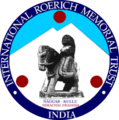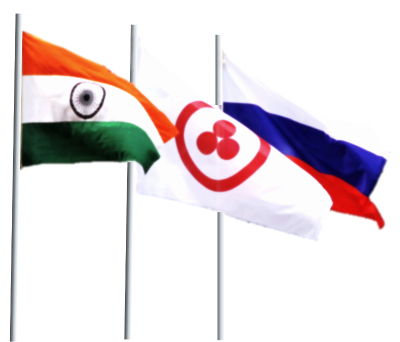Nicholas (Nikolai Konstantinovich) Roerich (1874 – 1947)
Nicholas Roerich belongs to the galaxy of outstanding figures of Russian and world culture. Painter, scientist, traveler, public figure, writer, thinker – his versatile gift can probably only be compared with the titans of the Renaissance epoch. Nicholas Roerich’s creative heritage is enormous – more than seven thousand paintings scattered all over the world, numberless literary works – books, essays, articles, diaries…
During that very same year, 1923, the master’s cherished dream came true – on December 2, N. Roerich and his family set foot in India. There the preparation for the most important journey in the life of the great artist started – an expedition to the remotest areas of Central Asia. These areas had for a long time attracted the attention of N. Roerich not only as a painter, but also as a scientist interested in a number of problems related to world migration patterns of ancient peoples, as well as to the search for a common source of Slavic and Indian cultures. Besides purely scientific goals, the expedition pursued an important evolutionary task. The expedition’s challenging itinerary ran through Sikkim, Kashmir, Ladakh, China (Sintzian), Russia (including Moscow), Siberia, Altai, Mongolia, Tibet and unexplored areas of the Trans Himalayas. This unique expedition’s significance and its results have not been fully appreciated by the modern geographic science up-until now. Despite this, Nicholas Roerich’s expedition realized Przhevalsky and Kozlov’s dream and became the triumph of Russian studies in Central Asia. In terms of its itinerary’s uniqueness and collection of materials, it can justly claim an exceptional place among major expeditions of the 20th century. The journey lasted from March of 1925 to May of 1928. For the first time, dozens of new mountain peaks and passes were marked on maps, archeological monuments were discovered, and incredibly rare manuscripts were found. Enormous scientific material was collected; books were written (“The Heart of Asia”, “Altai – Himalayas”); about five hundred paintings were created and, thanks to these, the artist immortalized a special and surprising world, that of high beauty.
1 S. Roerich. Striving for the Beautiful. M.: ICR, 1993. – P. 49. – (The Roerichs Small Library).
2 N. Roerich. Culture and Civilization. M.: ICR, 1994. – P. 60. – (The Roerichs Small Library).
3 N. Roerich. Diary Pages. M.: ICR, 2000. – V. 2. – P. 50.
4 N. Roerich. Culture and Civilization. M.: ICR, 1994. – P. 49. – (The Roerichs Small Library).
5 N. Roerich. Diary Pages. M.: ICR, 2000. – V. 2. – P. 82.
6 N. Roerich. About the Great Patriotic War. M.: ICR, 1994. – P. 30. – (The Roerichs Small Library).

An acquaintance with the Oriental philosophical thought was reflected in N. Roerich’s creative work. While the core subjects of the artist’s earlier paintings was ancient pagan Russia with its colorful images of the folk epos and primeval splendor of the uncorrupted natural element (“They Build a City”, “Idols”, “Guests from Overseas”, etc.), starting already from the middle of the first decade of the 20th century, the theme of India and the East appears increasingly more frequently on his canvases and in literary pieces.
In 1916, due to a severe illness of the lungs, in accordance with his doctors’ insistent advice, N. Roerich together with his family moved to Finland (Serdobol), to the Ladoga Lake coast. Proximity to Petrograd (Saint Peters-burg) allowed him to go from time to time to the city on the Neva river and deal with the Art Encouragement Society School affairs(with the affairs of the School under the Art Encouragement Society). However, after the revolutionary events of 1917, Finland closed its borders with Russia, and N. Roerich with his family found himself cut off from his Motherland.
In 1919, having received an invitation from Sweden, Nicholas Roerich traveled with exhibitions around the Scandinavian countries, and in the fall of the same year, he accepted S. Diagilev’s invitation to work as the designer for Russian operas to the music of M. Mussorgsky and A. Borodin in London, and together with his family went to England.
In 1920, N. Roerich got an invitation from the Director of the Chicago Institute of Arts to organize a big exhibition tour around 30 cities of the USA. Nicholas Roerich accepted that invitation, and left London together with his family.
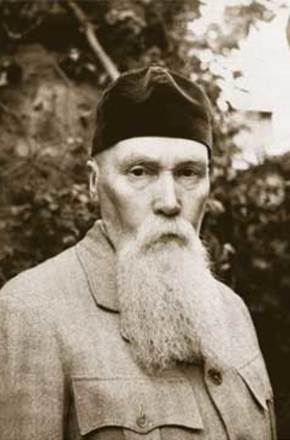
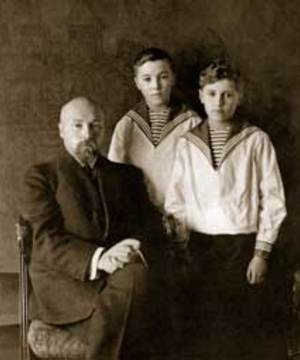
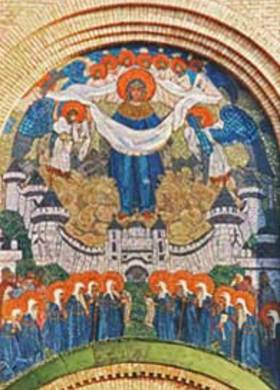
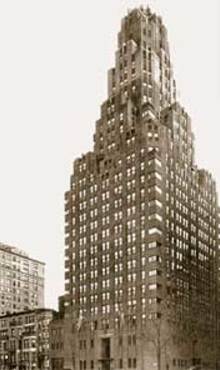
Nicholas Roerich was born in a family of the famous notary Konstantin Fedorovich Roerich in Saint-Petersburg, on October 9th, 1874.
From his childhood, he was attracted to painting, archeology, history, and, most of all, to the rich heritage of the East. All this merged together produced afterwards an amazing result, and made Nicholas Roerich’s creative work bright and unique.
Upon finishing the Karl May Gymnasium in 1893, Nicholas Roerich simultaneously enrolled in the Saint-Petersburg University Faculty of Law (he graduated from it in 1898) and the Imperial Academy of Arts. From 1895, he studied in the studio of the famous Arkhip Kuinji. At that time, he closely communicated with well-known cultural figures of those days – V. Stassov, I. Repin, N. Rimsky-Korsakov, D. Grigorovich, S. Diagilev.
In his books, N. Roerich called Helena Roerich “inspirer” and “friendess”. She was the first to whom he showed each of his new paintings and he highly appreciated her artistic intuition as well as her subtle taste. Many of the artist’s canvases were created on the basis of Helena’s images, thoughts, and creative insights. But her ideas were not only reflected in his paintings – it is hard to mention even one sphere in N. Roerich’s activities where these were not present. Behind each one of Nicholas Roerich’s creative acts, behind his verses and fairy-tales, behind his paintings and journeys – there will always be Helena Roerich. According to S. Roerich “collaboration of Nicholas and Helena Roerich was a most rare combination of full consonance on all planes. Supplementing each other, they seemed to merge in a richest harmony of intellectual and spiritual expression” [1, p. 49].
In 1903 – 1904, N. Roerich together with his wife made a trip to the old cities of Russia. They visited more than 40 cities famous for their ancient monuments. The aim of this “trip through antiquities” was the study of the roots of the Russian culture. The trip’s result was not only a wide series of the artist’s paintings, but also N. Roerich’s first articles. In them, he was one of the first to raise the issues concerning the great artistic value of old Russian icon-painting and architecture.
In 1897, N. Roerich graduated from the Saint-Petersburg Academy of Arts, and his final diploma painting, “Messenger”, was acquired by the famous collector of Russian pieces of art, P. Tretiakov.
At the age of 24, Nicholas Roerich had already become an assistant to the Director of the Emperor’s Art Encouragement Society Museum(Director of the Museum under the Imperial Society for the Encouragement of the Arts ) and, at the same time, editor assistant of the art magazine “Mir Iskusstva” (“World of the Art”).
In 1899, he met Helena Ivanovna Shaposhnikova who became his devoted companion and spiritual sister-in-arms for the rest of his life. Unity of views and deep mutual sympathy very quickly grew into strong and vibrant feelings, and in October 1901, the young couple got married. They would walk hand in hand through their whole lives and complement each other both creatively and spiritually. Helena Roerich would share all of Nicholas Roerich’s aspirations and initiatives. In 1902, their son Yuri was born, the future scientist-orientalist, and in 1904 – Svetoslav, who would choose the same path as his father.
The artist’s paintings on religious subjects in the form of frescoes and mosaic sketches for Russian churches also refer to the same period.
Nicholas Roerich’s multi-faceted talent brightly manifested itself in his works for theatre stagings. During S. Diagilev’s famous “Russian Seasons”, N. Roerich designed the staging of “Polovtsian Dances” from Borodin’s “Prince Igor”, Rimsky-Korsakov’s “Pskovityanka”(Pskovian woman), and the ballet staging of the “Sacred Spring” to Stravinsky’s music. Thanks to Helena Roerich, Nicholas Roerich became acquainted with the works of outstanding Indian thinkers – Ramakrishna and Vivekananda – they also became familiar with R. Tagor’s literary pieces and they studied together the Upanishads.
N. Roerich belonged to the galaxy of those few thinkers of the 20th century who deeply understood the true significance of Culture and its crucial role in the development of mankind. “Culture rests on Beauty and Knowledge” [2, p. 60], he wrote, and repeated Dostoyevsky’s famous phrase with a little modification: “Comprehension of Beauty will save the world”[3, p.50]. This formulation covers practically the whole essence of cosmic evolution, which moves from chaos to order, from the simple to the complicated, from system to Beauty. Beauty is only cognized by man through Culture, integral part of which is creative work. This is also discussed in the Living Ethics books, in the creation of which the Roerichs took part directly. Helena Roerich put the Living Ethics’ cosmic ideas in writing and Nicholas Roerich perpetuated them in beautiful artistic images.
Putting into practice these ideas, N. Roerich conducted wide cultural and educational activities in America. In November of 1921, the Master Institute of United Arts was opened in New York, the main purpose of which was to bring peoples together through culture and art. Almost at the same time, artists association “Cor Ardens” (“Blazing Hearts”) was established in Chicago, and in 1922, the International Cultural Center “Corona Mundi” (“Crown of the World”) appeared. In 1923, the New York Nicholas Roerich Museum opened its doors. It contained the richest collection of the artist’s paintings. Institutions founded by Nicholas Roerich became major centers of culture in America, uniting many famous workers of art.
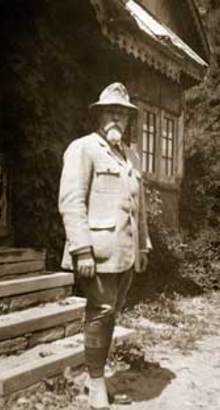
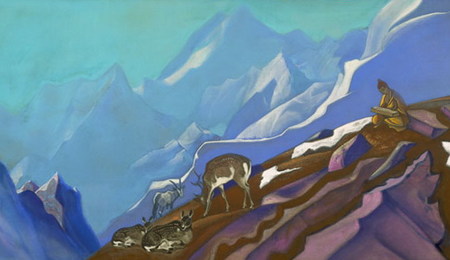
In the 1930-s, anticipating the threat of a forthcoming war, N. Roerich developed a project of a special Pact for the protection of cultural values in times of warfare and civil strife. Roerich’s Pact had a great educational significance. “A pact for protection of cultural treasures is not only needed as an official body, but as an educational law that, from the very first school days, will educate the young generation with noble ideas of preservation of the whole of mankind’s true values”[5, p. 82]. This cultural initiative was supported in the widest circles of the world community. The artist’s idea was welcomed by R. Rolland, B. Shаw, R. Tagorе, A. Einstein. The Pact was signed in the White House in Washington, on April 15th, 1935. At first, 21 countries of the American continent ratified the document. Subsequently, in 1954, Roerich’s Pact was placed at the very foundation of the Hague “International Convention for the Protection of Cultural Values in the Event of Armed Conflict.” N. Roerich also suggested a special flag, the Banner of Peace, that would mark all treasures of culture and art inviolable objects. To this day, the flag waves above many cultural and educational institutions all over the world.
After the expedition ended in July of 1928, N. Roerich founded the Institute of Himalayan Studies “Urusvati” that translates from Sanskrit as “The Light of the Morning Star”. In this very place, the Kullu Valley in the Western Himalayas, Nicholas Roerich and his family found their home. There, in India, the artist lived out the last period of life.
In 1934-1935, Nicholas Roerich headed an expedition to the areas of Inner Mongolia, Manchuria, and China, organized by the US Ministry of Agriculture with the purpose of studying drought resistant plants.
During N. Roerich’s expedition, the President of New York’s Nicholas Roerich Museum and N. Roerich’s authorized representative, the American businessman Louis Horch, falsified a series of documents and slandered his Teacher. He then illegally seized the Museum’s batch of shares and proclaimed himself its owner. He secretly removed the paintings and kept a part of them for himself. The vast majority of the canvases were sold at an auction and are still decorating private American collections. After some time, a group of museum workers devoted to the Roerichs obtained new premises for the Museum and acquired a considerable portion of the paintings.
N. Roerich went on with his International cultural activities. In his philosophic and artistic essays he created an absolutely new concept of culture that is based on the ideas of the Living Ethics. Culture, in N. Roerich’s opinion, is closely related to the problems of cosmic evolution of mankind and is and is the greatest foundation of this process.
N. Roerich included in the broad notion of Culture a synthesis of the best achievements of human spirit in the sphere of religious experience, science, art and education. It was Nicholas Roerich who for the first time formulated the concept of the essential difference of Culture from civilization.
Nicholas Roerich’s essays and letters from that period as never before called for human unity and friendship. The most important things, Nicholas Roerich asserted, are within ourselves, in the power of our spirit, in our internal culture, the basis for which is kind-heartedness, aspiration for knowledge, and respect for Beauty.
These calls were never abstract. Not only N. Roerich’s artistic and literary works were based on these principles, but so too his whole life. His contemporaries’ recollections, besides admiration for the versatility of his creative genius, convey the image of a purposeful man, who was striking by his extraordinary spiritual power, internal harmony, and extreme tolerance for other people’s views.
From the very first days of the Second World War, Nicholas Roerich made every effort to help his Motherland, even whilst being removed from her. Together with his younger son S. Roerich, he arranged exhibitions and sales of paintings so that he could transfer all the proceeds to the Red Army fund.
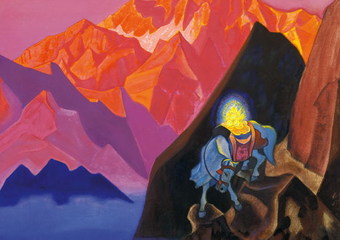
The fact that more than a hundred institutes, academies, scientific corporations and cultural institutions in the whole world have chosen him as their honorary and full member confirms the Russian painter’s worldwide recognition. The artist was treated with great respect in India itself as well: famous Indian philosophers, scientists, writers, public figures were personally acquainted with Nicholas Roerich. Many common Indians honored him as a great sage.
Recognition of N. Roerich’s services for public, scientific, and artistic activities in no way affected his attitude towards his Motherland. He always remained a patriot and a Russian citizen who only held one passport – Russian. N. Roerich never gave up the thought of coming back to his country. Right after the end of the war, the artist applied for a visa to enter the Soviet Union. But his intentions were not to be realized – in the full swing of preparations, on December 13, 1947, he passed away, without knowing that he had been denied his visa…
On the spot of his funeral pyre, facing magnificent snowy peaks, a big rectangular stone was installed on which the following inscription was carved: “Here, on December 15th, 1947, the body of Maharishi Nicholas Roerich – a great Russian friend of India – was committed to fire. Let there be peace”.
Text and photo from en.icr.su
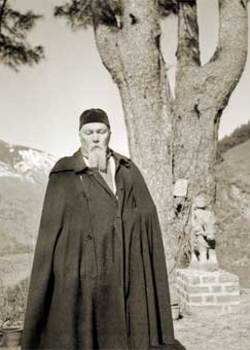
N. Roerich with his sons. 1914-1915
N. Roerich. The Protecting Veil of the Holy Mother of God. 1906 – 1907. Church of the Protecting Veil of the Holy Mother of God. Village of Parkhomovka, the Kiev Region.
(Mosaics are performed by V. Frolov)
Nicholas Roerich Museum in New York. 1929 – 1938
N. Roerich. Kullu. 1930s
N. Roerich. Chintamani. 1935–1936
N. Roerich. Kullu. 1940s
While Culture relates to the spiritual world of man in his creative self-expression, civilization is just the external arrangement of human life in all its material and civil aspects.
The identification of civilization with Culture, Nicholas Roerich argued, leads to confusion between these two notions, as well as to underestimating the spiritual factor in the development of humanity. “Wealth in itself does not generate Culture. But broadened and subtler thinking and the sense of Beauty produce that subtlety, that nobility of spirit which are distinctive for a cultured person. It is this kind of person that can build radiant future for its country” [4, p. 49]. Proceeding from this, mankind must not only develop Culture, but is also obliged to protect it.
In those years, formidable for Russia, the painter turned again to the subject of the native land in his creative work. In that period, he created a whole series of paintings – “Prince Igor”, “Alexander Nevsky”, “Guerrilla Fighters”, “Victory” – in which, using the images of the Russian history, he predicted the Russian people’s victory over fascism.
N. Roerich. The Book of Life. 1930s
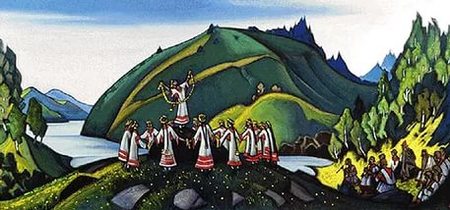
N. Roerich. The Sacred Spring. 1945
Many articles were published in newspapers; radio interviews were given to support the Soviet people. There was no single note of despondence or bewilderment. Even in the most critical days of the war, there was only confidence in the Russian people’s victory: “We argued with many unsure, hesitant people. False prophets predicted all kinds of calamities, but we always said: “Moscow will withstand!”, “Leningrad will withstand!”, “Stalingrad will withstand!”. And here we are, they did withstand! To the whole world’s surprise, unconquerable Russian warrior-host has grown!” [6, p. 30], Nicholas Roerich wrote in the article “Glory” in 1943.
